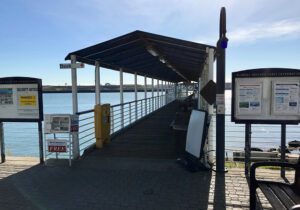
The San Francisco Bay Area Water Emergency Transportation Authority (WETA), the agency that provides ferry service to the San Francisco Bay, announced in January that its Main Street Alameda Ferry Terminal has re-opened for service after a 10-week closure for major refurbishment.
The refurbishment project included the repair and replacement of the existing terminal infrastructure to bring the site into compliance with current seismic safety requirements. Improvements include bridge and foundation replacement, gangway replacement, float replacement and utility upgrades.
The project design also included elements to facilitate future electrification of the terminal for zero-emission ferry vessels. Direct benefits to passengers include more efficient ferry operations and modernized terminal lighting.
The project, WETA said, finished on time and within the $10 million budget approved by its Board of Directors.
Seattle-based Manson Construction Co. was responsible for final design, demolition, construction and fabrication of ferry terminal components. The firm Jacobs served as WETA’s construction manager, working with the City of Alameda to ensure project delivery.
“This much-needed terminal refurbishment in Alameda improves the passenger experience, as well as safety and resilience for our skilled mariners,” WETA Board Chair Jim Wunderman said. “It also shows our continued investment in Alameda, a bedrock ferry community.”
The project was funded with Federal Transit Administration (FTA) grants and Alameda County transportation sales tax revenues.
It was finished weeks after WETA was awarded a $16 million grant from the Federal Transit Administration (FTA) to charge up its Rapid Electric Emission-Free (REEF) Ferry Program, a transformative suite of projects to transition its fleet to zero-emission propulsion technology.
The grant is funding the electrification of four ferry floats at the Alameda Seaplane, Downtown San Francisco and Main Street Alameda ferry terminals. The float electrification project involves structural modification to the passenger floats, procurement and installation of battery banks, grid connections and installation of vessel charging equipment.
“We’re entering a second golden age of ferries here in the Bay Area, and I’m proud that WETA is leading the global effort to decarbonize the industry,” WETA Board of Directors Vice Chair Monique Moyer said in November. “(T)his grant is transformative for our local efforts to reduce pollution while providing an amazing transit experience.”
WETA has selected Finnish company Wärtsilä, which manufactures and services power sources and other equipment in the marine and energy markets, as its electrification systems integrator for the REEF Ferry Program.
Seattle-based Elliott Bay Design Group has been selected as the design and construction management firm for a set of new 300-passenger battery-electric vessels. Aurora Marine Design, based in San Diego, is filling that role for a class of smaller battery-electric vessels to serve the San Francisco waterfront, as well as consult on the overall zero-emission system architecture.

